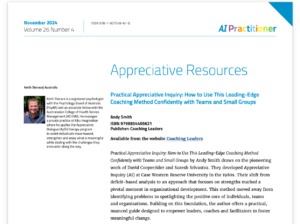How Does the 5-D Format Compare to the GROW and TGROW Models?

[ad_1]

If you have any prior experience of coaching you may well have used the GROW model, probably the most widely used format in coaching, and you may be curious about how the Appreciative Inquiry 5-D format relates to it.
The GROW model, developed by Graham Alexander and popularised by Sir John Whitmore in his book Coaching For Performance, is designed to provide a structure for a coaching session in these stages:
- Goal – the topic you want to work on, your desired outcome for this session, and/or the long-term goal this is related to
- Reality – exploring the present situation
- Options – options generated by the coachee for reaching the goal
- Wrap-up (or What next?, Way forward, or Will) – the coachee chooses an option and plans how to implement it.
In some presentations of the model (e.g. in Effective Coaching by Myles Downey) the Topic for coaching is separated out from the specific goal or goals to provide the overall context and perhaps the longer term vision, giving us the TGROW model.
So how does the 5-D model relate to the GROW and TGROW models?

The Definition stage is similar to the Topic in TGROW, or the topic part of the Goal stage in the original GROW version. The difference is that the topic in TGROW may be defined in problem language, in terms of what the coachee wants to avoid or get away from, which would switch on (or maintain) the Task Positive or ‘analytic’ network in the coachee’s brain, rendering them less capable of coming up with new ideas later in the coaching session. It also makes it harder for them to trust or even maintain rapport with the coach, and less open to suggestions. As one characteristic of the Task Positive network is that it encourages focus on the problem or target to the exclusion of the wider picture, it will also make the ‘establishing context’ aspect of the Topic stage harder if the topic is framed in problem language .
In the Definition stage of the 5-D model, by contrast, the problem is reframed or ‘flipped’ into an affirmative topic framed in positive language that focuses on what the coachee wants rather than what they want to get away from or avoid. This is more likely to activate the coachee’s ‘Default’ or ‘empathic’ mode, essential for open, creative thinking and trust in the coaching relationship.
The Discovery stage is similar to the Reality stage in the GROW model, but with the crucial difference that we are focusing on what’s already working (or has worked in the past). The exploration of Reality in the GROW model could ask problem-focused questions like “What stopped you from doing more?” – indeed, it’s likely to include discussions of obstacles and limitations, given the human brain’s tendency to pay more attention to negatives and threats than positives and opportunities. Again, this will keep the coachee in ‘Task Positive’ / Analytic mode, and sap their motivation and sense of agency.
The Dream stage is in some ways similar to the Goal stage in the GROW model. A crucial difference is that in the 5-D format the Dream comes after the Discovery stage – the coachee is not expected to dream up their goal without first exploring where they currently are. The GROW model, by contrast, presupposes that the goal is clear from the start, which it may not always be. In practice it can be hard to know what your goal should be until you have explored the current situation.
Also, the Dream stage is establishing a direction. It’s not setting a quantified and timed SMART goal, and it’s not making a premature assessment of how ‘realistic’ the desired outcome is – such an assessment would be more the product of the client’s belief system than anything based on objective reality anyway.
The Design stage performs a similar function to the Options stage in GROW. The appreciative approach in the 5-D format is more likely to result in more creative options, because the coachee will have been psychologically primed by the preceding stages to feel more creative and less defensive. Also, they may well have gained some ideas from exploring what has worked in the past during the Discovery stage.
The Delivery stage in the 5-D model is again broadly similar to the Wrap-Up in GROW. In both formats, the coachee selects the actions they want to take forward from the ideas generated in the preceding stage.
It would, of course, be possible (with a little care) to focus on the positive aspects of the coachee’s situation during a GROW or TGROW coaching session. Even so, it would miss the crucial information gathering and psychological priming effects that come from Discovering examples showing that individual’s strengths and what works for them before establishing goals and actions.
[ad_2]




